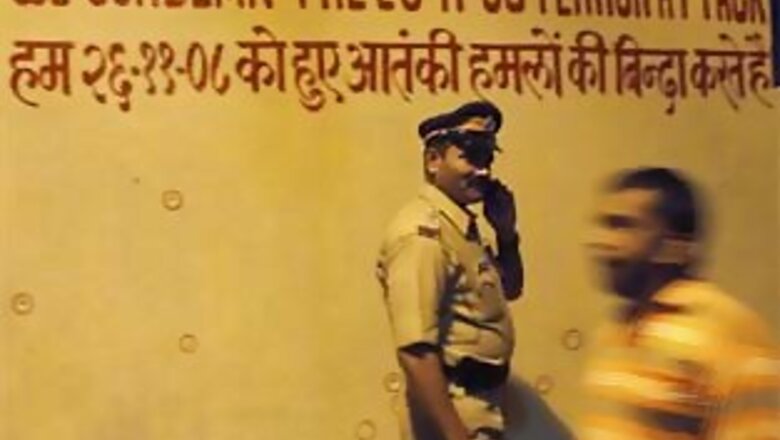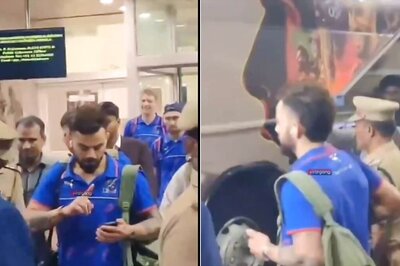
views
Mumbai: Coastal security is being shored up, a special commando unit is being trained and police equipment is being modernised among many other measures under way. A year after the devastating 26/11 terror attacks, securing Mumbai is still a work in progress, admit officials.
The 60-hour siege in Mumbai beginning on the night of November 26, 2008, exposed the complete unpreparedness of the security establishment in tackling the most daring non-military attack seen in the country so far.
A year down the line, there has been a tightening of coastal security, revamped security measures in important buildings in the financial capital and more checks on the rail network system that is the city's lifeline.
But a lot more needs to be done.
"Many systems are in place that was absent a year back. But let me be frank and tell you that it is still a work in progress. However, what I can say confidently is that there is a heightened sense of security and the operational preparedness of the police has improved," says Mumbai Police Commissioner D Shivanandhan.
"Basic protocols are in place."
Shoring up coastal security and tightening measures on the city's sea front have been given topmost priority.
The 10 terrorists had sneaked in undetected into Mumbai from the sea route, fanning out into the city to go on a killing spree that claimed 166 lives. Nine of them were killed, and one, Mohammed Amir Kasab, is in custody.
That is a story that will never be repeated, vow officials.
Given the vulnerability of the sea borders - the Arabian Sea on the west, the Indian Ocean on the south and the Bay of Bengal in the east - multiple security agencies, including Mumbai Police, have been acquiring or deploying additional boats to keep an eye on the country's western coast.
Just last week, navy chief Admiral Nirmal Verma conducted a detailed review of the Western Naval Command in Mumbai to check its operational preparedness.
The Indian Navy has drawn up major plans to acquire five midget submarines - weighing around 150 tonnes - for its Marine Commandos (MARCOS) unit for underwater surveillance missions and covert operations in high seas.
MARCOs played an instrumental role in eliminating the terrorists during the three-day siege.
"The terror attacks in Mumbai have resulted in a bigger role for the Indian Coast Guard. Work is under way to put in place a chain of 46 coastal radars spanning nine coastal stations," says Defence Minister AK Antony.
For strategic reasons, the current emphasis is on strengthening the security on the west coast, which incidentally proved a haven for terrorists even during the March 1993 serial bomb blasts that killed over 250 people.
A couple of months ago, police acquired two indigenous bulletproof boats, built by the Goa shipyard at a cost of nearly Rs 4.5 crore.
Efforts are also on to ensure that police are equipped to combat the terrorists.
The state government plans to spend Rs 630 crore on modernising its force; this will mean an upgraded anti-terrorist squad, better weaponry and equipment and state-of-the-art control rooms.
"The state authorities are also raising a special commando unit called Force One, with 238 recruits undergoing training near Pune. Soon Mumbai will also be wrapped in CCTVs," says Shivanandhan.
In the last six months, metal detectors, dog squads and gun-toting security personnel behind sandbags have been positioned at important installations across the city. These include railway stations, airports, ports, malls, multiplexes and deluxe hotels.
"Sure there is heightened security and some of it is unobtrusive as well, which is good. There is a lot of awareness post-26/11 and even people are careful. However, the biggest challenge of security agencies is to pre-empt any terror strikes," says tax consultant and long-time Mumbai resident JP Purohit.
Last month, a high-level team of security experts from the National Security Council, the elite National Security Guard (NSG) and other security agencies arrived to take stock of the operational readiness of the civic agencies in the face an emergency.
After visiting the Municipal Corporation of Greater Mumbai (MCGM), the Chhatrapati Shivaji Terminus (CST) and Mantralaya at Nariman Point, the team discovered that the city's communication, transport networks and the disaster management systems were still vulnerable.
The team suggested alternatives like connecting disaster management control rooms of Mumbai and Delhi with hotlines, using HAM radios and developing waterways in case the city's road and rail networks collapsed. Almost 75 lakh people commute on trains every day.
For a city that has been witness to horrific terror attacks in the past, 26/11 was a rude wake-up call not just for the authorities here but also for the rest of the country. Authorities now believe they have been able to establish basic strategies and tactics for an appropriate terror response.
The job is still unfinished, however.

















Comments
0 comment